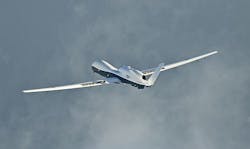Navy orders three MQ-4C Triton long-range maritime surveillance UAVs for anti-submarine warfare (ASW)
Officials of the Naval Air Systems Command at Patuxent River Naval Air Station, Md., announced a $303.9 million order last week to the Northrop Grumman Aerospace Systems sector in San Diego for the three Triton low-rate initial production UAVs as part of the second lot of Triton production.
Northrop Grumman is developing the MQ-4C Triton, also called the Broad Area Maritime Surveillance (BAMS) UAV, to fly maritime surveillance missions as long as 24 hours at altitudes of more than 10 miles to enable coverage out to 2,000 nautical miles. The UAV's suite of sensors can detect and classify different types of ships automatically.
Last week's order includes one Triton main operation control station, one forward operation control station, trade studies, and tooling.
The Triton will be a crucial component of the Navy's 21st century strategy for conducting surveillance of surface ship and submarine traffic in the vast Pacific and other oceans around the globe. The Triton UAV will work together with the Navy's P-8A Poseidon manned maritime patrol aircraft.
The Triton's maritime search radar is called the Multi-Function Active Sensor (MFAS), and will provide the UAV and its operators with a 360-degree view of a large geographic area while providing all-weather coverage for detecting, classifying, tracking, and identifying points of interest. MFAS is separate from the Triton's air-to-air radar. The MFAS radar first flew on the Triton during testing in April 2015.
Along with the air-to-air and MFAS radar systems, the MQ-4C will carry an electro-optical/infrared (EO/IR) sensor that will provide still imagery and full-motion video of potential threats; an electronic support measures package to identify and geolocate radar threat signals; and an Automatic Identification System (AIS) that will detect and track vessels equipped with AIS responders. The Triton should be ready to deploy by this year.
The MQ-4C Triton is designed to provide combat information to military authorities like the expeditionary strike group, carrier strike group, and the joint forces maritime component commander. The Triton air vehicle is based on the U.S. Air Force RQ-4B Global Hawk, while its sensors are based on components and systems already fielded in the U.S. military.
The large unmanned aircraft provides intelligence for large ocean areas to maintain the common operational and tactical picture of the maritime battle space. The Triton feeds intelligence, surveillance, and reconnaissance (ISR) data to the Global Information Grid (GIG), and can work alone or together with other aircraft and surface ships.
The MQ-4C Triton's ability to perform persistent ISR within a practical range of 2,000 nautical miles enables the P-8A aircraft to focus on anti-surface ship warfare, anti-submarine warfare (ASW), and multi-intelligence. It can fly as far as 8,200 nautical miles without refueling.
Triton aircraft and support facilities are being based domestically at Point Mugu Naval Air Station near Ventura, Calif., and at Jacksonville Naval Air Station, Fla. Triton UAVs also will be forward-deployed to Kadena Air Base, Japan; Andersen Air Force Base, Guam; Sigonella Naval Air Station, Italy; as well as at installations on the islands of Hawaii and Diego Garcia.
The Triton UAV has a Rolls-Royce AE3007H jet engine, can remain aloft for as long as 24 hours, can fly as fast as 320 knots, and fly as high as 60,000 feet. The unmanned aircraft is 47.6 feet long, 15.4 feet high, has a wingspan of 130.9 feet, and has a maximum takeoff weight of 32,250 pounds. It can carry as much as 17,300 pounds of fuel, sensors, and other payloads.
The Triton has a ground crew of four -- an air vehicle operator, tactical coordinator, and two mission payload operators. Triton development began in early 2008 with a $1.2 billion contract to Northrop Grumman to design and build two Triton UAVs with mission payloads and communications suites; one forward operating base mission control system; one systems integration laboratory; and one main operating base mission control system.
On this contract Northrop Grumman will do the work in San Diego, Palmdale, and Santa Clarita, Calif.; Red Oak, Texas; Baltimore; Salt Lake City; Bridgeport, W.Va.; Indianapolis; Moss Point, Miss.; Montreal; Vandalia, Ohio; Medford, New York (0.3 percent), and other U.S. locations, and should be finished by April 2021.
For more information contact Northrop Grumman Aerospace Systems online at www.northropgrumman.com, or Naval Air Systems Command at www.navair.navy.mil.
Learn more: search the Aerospace & Defense Buyer's Guide for companies, new products, press releases, and videos
